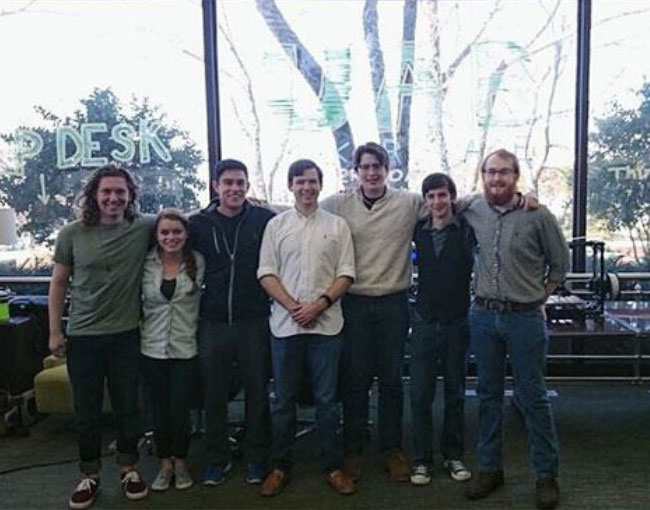Author: Emily Haley
Earlier this year, I had the pleasure of meeting Forrest Satterfield, a junior biomedical engineering major here at UAB who has a passion for innovation and problem solving. During his time at UAB, Forrest has established himself as an entrepreneur by founding and leading Satterfield Technologies, the first startup company of the UAB Collat School of Business's Innovation Lab.
Although Forrest wanted to be an entrepreneur from a young age, the idea for his company emerged during his freshman year at UAB. The original concept for the product consisted of a series of three actuators, or small motors with built-in computers, that would power prosthetics and orthotic braces. However, Forrest’s company and target product has evolved in tandem; the current model involves using a laser scanner and 3D printer to produce custom prosthetics and orthotics with modular sensors and interchangeable actuators. These components will be combined in a mix-and-match fashion based on the patients' needs and budgets, a model that will prioritize affordability without sacrificing quality.
As an engineering student and entrepreneur, Forrest has a unique perspective on the design process and its integration in business. When asked about how the scientific process has contributed tohis work, Forrest explains that the scientific method has been mainly involved in the business aspects of his project, like testing a certain product component or business model. He will predict a particular outcome, rigorously test the product or idea, evaluate the results and proceed with building, or redesign and retest if needed. For the engineering aspects, most of the research involved has been data sourcing to learn all available information that could aid in developing ideas for the new design.
Stressing the importance of multidisciplinary study, Forrest readily acknowledges that his knowledge of business has been invaluable to the development and success of his engineering project. Throughout this endeavor, Forrest has discussed his project with UAB faculty members, as well as local businesses, businessmen, and engineers; he has been able to use their different viewpoints as a system of checks and balances to manage the strengths and weaknesses of his project. Engineers, he says, tend to focus on the idea and exploring the full possibilities of the technology, while the business viewpoint reminds him that one of the most important goals is to produce a product that meets the wants and needs of the consumer. Forrest points out that while it has always been important for researchers to have a rudimentary understanding of the business perspective, it is becoming even more advantageous to be able to communicate in the business vernacular and present statistical evidence so that the product will be accepted by the targeted consumers. He credits the business certificate program at the Mervyn Sterne Library for providing him with these skills and resources, and he strongly recommends the course to other researchers who are considering distributing their products to the public.
In addition to his work as an entrepreneur, Forrest serves as a University Innovation Fellow, a title that comes with the responsibility to “increase student innovation and entrepreneurship.” To this end, Forrest has spearheaded the development of the UAB Makerspace, which is designed to provide important tools to students participating in innovative design projects by “catalyzing cross-disciplinary collaboration, facilitating connecting students with university resources and faculty, and enabling students to quickly prototype and test their ideas.” The Makerspace, located in Sterne Library, held its Grand Opening on February 22, 2016, and has five 3D printers and four HP sprouts, as well as circuit scribe kits, laptops, and more. Students can use these tools for virtual reality, software design, circuit building and design, as well as 3D printing anything from flower pots and figurines, to anatomical models and senior engineering design projects. Forrest is currently open to collaboration with interested students and other members of the community and would be happy to provide more information about his experiences and current project by email at fvsatt7@uab.edu.
Forrest also acknowledges the great difficulty and importance that is associated with identifying mentors to provide advice in entrepreneurial endeavors. In fact, the hardest part of Forrest’s experience was finding mentors to help guide him throughout his project. To find mentors, he researched professors who were involved with or interested in work similar to his start-up. After identifying these professors, he persistently, but respectfully, contacted them by email. In doing so, he learned to be genuine in explaining his goals while remaining open to criticisms and changing hisideas to get mentors to commit to his project. In this spirit, he says, "I love to help people achieve their potential...helping people to reach their goals appeals to me."
Forrest concludes with a word of advice to our readers: "There is no such thing as success the first time. It is probability, not luck, that puts a person in the right place at the right time. So reach out to everyone and remember that it is better to receive no response than to have lost the opportunity to try."

Forrest Satterfield (center) with his fellow student workers in the UAB Makerspace.
